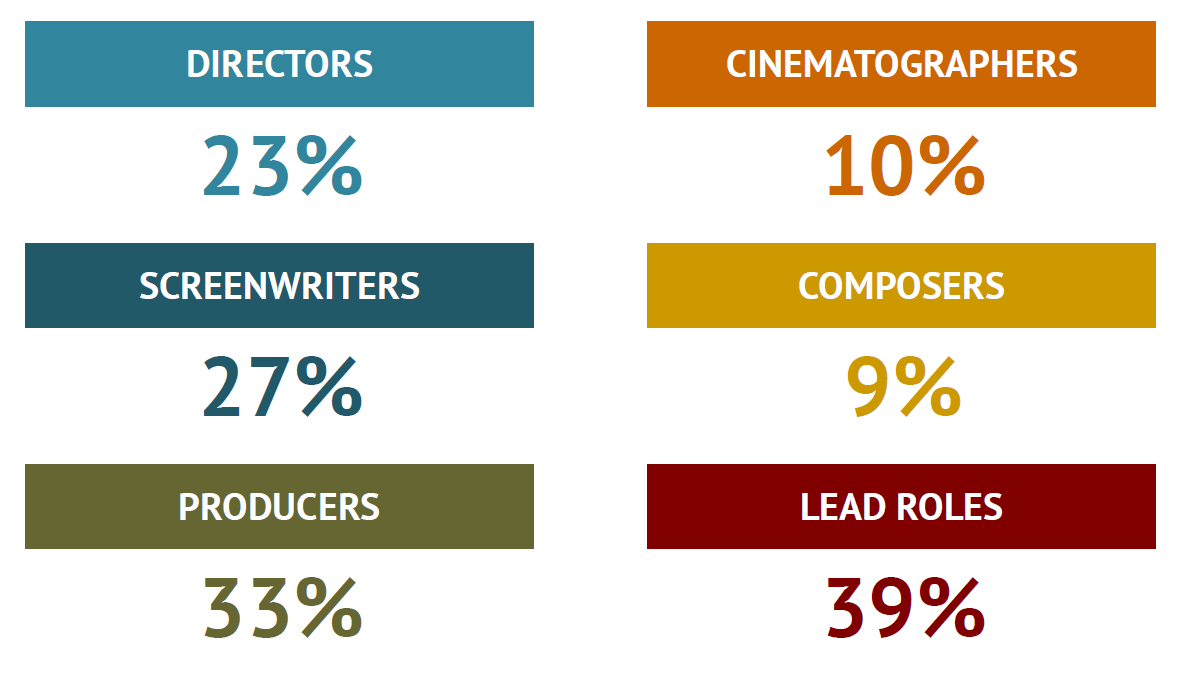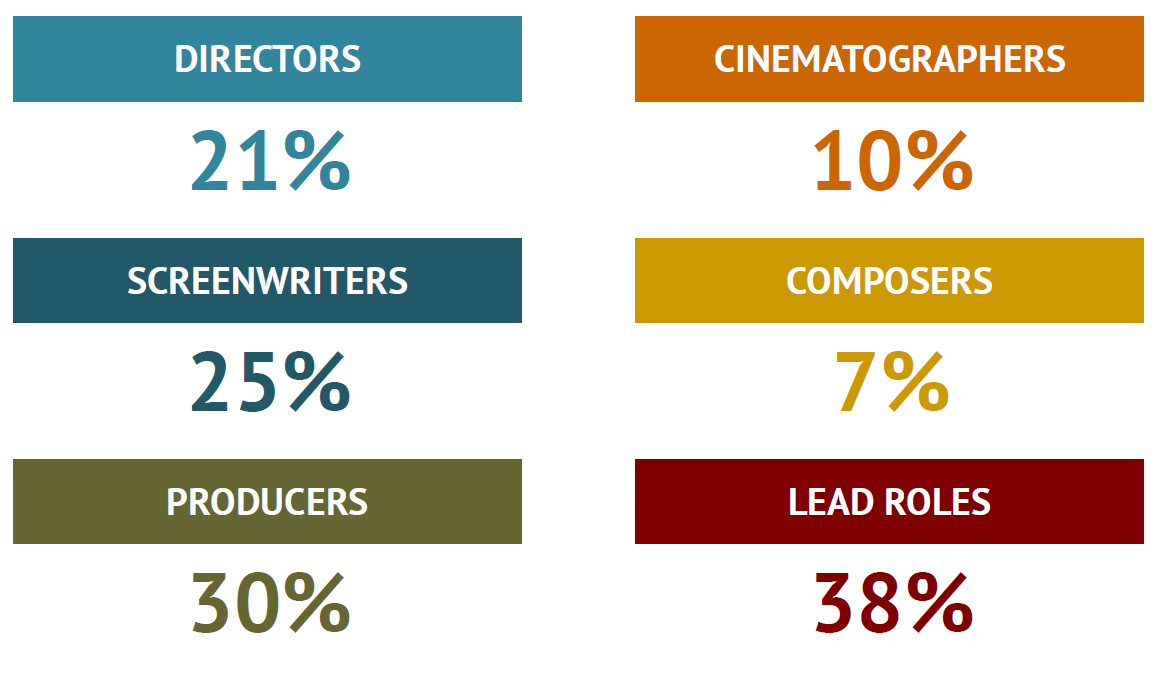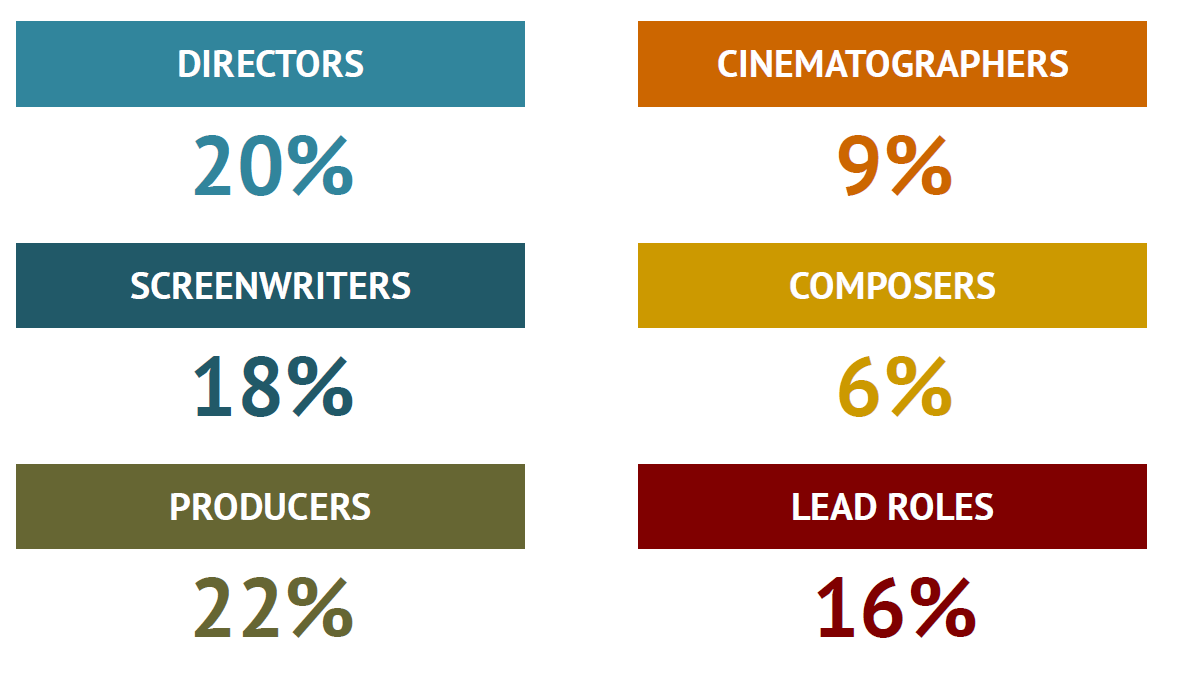Download “Female professionals in European film production” here
Key insights for the period 2016 – 2020:
- Women represented less than one film director out of four in Europe.
- The gender gap was less pronounced among producers and screenwriters: women accounted for 33% of producers and 27% of screenwriters active in European feature films.
- The female presence was lowest among cinematographers (10%) and composers (9%).
- Women working in film crews in key roles tended to work in teams more often than their male colleagues and they were less likely than men to be the sole professionals working in a given role on a feature film.
- On average, women working in behind-the-camera roles worked on slightly fewer films than their male counterparts.
- Between 2016 and 2020 the average share of female directors per film was only 20%, with no significant evolution over the years. This figure was 25% for screenwriters.
- The share of films by female-majority teams was higher for documentary films than for other film genres, taking into account all professional categories.
This report provides an assessment of the gender imbalance among film professionals within the European film industry. Our analysis includes an overview of the gender of professionals who have worked on at least one European feature films in one of the following key roles:
- Director
- Screenwriter
- Producer
- Cinematographer
- Composer
- Actor in a lead role.
In addition, the report explores the gender composition of professional teams and identifies the share of films led by female-majority teams.
1. Women are significantly underrepresented among film professionals working in key roles behind the camera
Women only represented 23% of all directors of European feature films active between 2016 and 2020. As for professionals working “behind the camera”, the female presence was slightly higher among producers (33%) and screenwriters (27%). In turn, the gender gap was more pronounced among composers and cinematographers, where women respectively accounted for only 9% and 10% of active professionals. The analysis suggests that female presence was more balanced “on screen”, with women accounting for 39% of all actors appearing in a lead role in a feature film.
Share of active female film professionals, by professional category (2016-2020)
Source: European Audiovisual Observatory / LUMIERE
Across all categories except lead roles, the prevalence of female professionals was higher in documentary films than other film genres. For instance, women accounted for 29% of directors of documentaries compared to 19% for live-action fiction films and 16% for animated fiction films.
2. Behind the camera female professionals in key roles tend to work in teams more often than men
Based on the data in our 2016 – 2020 sample, women working in film crews were more likely than men to work in partnership with other colleagues in the same role, a pattern that can be observed across all categories considered. Taking into account feature films written by at least one female screenwriter, 68% were co-written with another professional. This compares with only 57% of films co-written for cinema by at least one male screenwriter. Therefore, female screenwriters were less likely than men to be the sole writer for a film: only 32% of films were written by one female screenwriter compared to 43% films by only one male writer.
Breakdown of European feature films by gender of screenwriter (2016-2020)
Source: European Audiovisual Observatory / LUMIERE
Female professionals in our sample were also proportionally more likely than men to work in gender-mixed teams. When a female screenwriter worked on a film in partnership with other colleagues, it was in the majority of cases in with at least one male colleague, that is within gender-balanced or male-driven teams, as opposed to female-driven teams. This pattern can be observed across all categories, but it is more relevant for screenwriters and producers, who often work in teams, rather than “solitary jobs” such as directors and cinematographers.
On average, women in all groups were slightly less active then their male counterparts. For instance, 89% of female directors only directed one single film, compared for 83% for men.
For these reasons, when considering the female and male proportion among all professionals involved in each film, the average share of women per film was even lower than than the share of active female professionals in each sub-group. For instance, the average share of female directors and screenwriters per film were only 21% and 25% respectively. However, significant differences can be observed across European countries.
In all sub-groups, the average share of female professionals per film is progressing slowly and was overall stable during the time frame considered in this analysis.
Average share of female professionals per film, by professional category (2016-2020)
Source: European Audiovisual Observatory / LUMIERE, Plurimedia
3. Only a minority of feature films were written or produced by female-driven teams
Between 2016 and 2020, only 18% of European feature films were written by a female-driven team (i.e. by a majority of female professionals in the role of screenwriter). Looking at the production department, the share of films produced by female-driven teams was 30%. This figure is much lower for cinematographers (10%) and composers (7%).
Taking into account all professional categories, documentary is the film genre with the highest share share of titles by female-driven teams. In all groups, the share of works by majority-female teams of professionals has not substantially changed over the analysed timeframe.
Share of works by female-driven teams of professionals (2016-2020)
In this context, “female-driven” refers to feature films or audiovisual fiction episodes by a majority (≥ 60%) of female professionals working in each role. Works by female-driven teams can be made either: by one individual female professional; by several female professionals; by teams of professionals of both genders with a female presence of at least 60%.
Source: European Audiovisual Observatory / LUMIERE, Plurimedia
Methodological note
The analysis presented in this report draws on data from European Audiovisual Observatory’s LUMIERE database, which collates annual admissions to theatrically released films from a variety of sources, including national film agencies. The study sample comprises European feature films produced between 2016 and 2020 and released in European cinemas during the same period. The dataset only includes films for which if was possible to track at least one commercial screening in one of the European markets covered in the LUMIERE database.
The analysis only includes feature-length films, leaving out compilations of short films and event cinema screenings.








